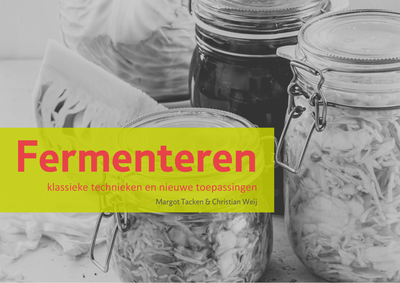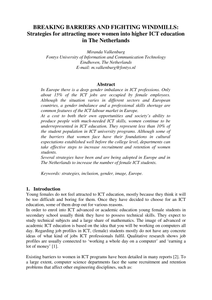Veel van onze favoriete voedingsmiddelen zijn gefermenteerd: brood, kaas, yoghurt, chocolade, koffie, olijven, salami, zuurkool, wijn, bier. De techniek van fermenteren is eeuwenoud en geniet een toenemende belangstelling. Wat gebeurt er in een product, tijdens een fermentatieproces, op het niveau van micro-organismen en moleculen? Hoe ontstaan de complexe smaken? Zijn gefermenteerde producten veilig en gezond? Welke rol kan fermentatie spelen in duurzame voedselproductie? Deze reader geeft antwoorden op deze vragen. Toepassing als onderwijsmateriaal (bovenbouw vo, mbo, hbo); bevat twee recepten en verwijzingen naar video’s en experimenten.Deze tekst verscheen in verkorte vorm in: Lugtenberg, Ben. (Red.) (2023). "Gezond met Microben".
DOCUMENT

This article describes a relatively straightforward procedure to knock out the gene that encodes the invertase enzyme in baker’s yeast. The SUC2 gene, which encodes for the invertase enzyme, is knocked out by a single-step PCR knock out method. The knockout is subsequently confirmed at the genetic level by PCR and agarose gel electrophoresis. The knockout is confirmed at the biochemical level by measuring the activity of the invertase enzyme using a colorimetric assay. This tips and tools article describes an easily scalable, inexpensive, yet challenging research project helping undergraduate students at the Bachelor level to conceptualize the effect of the deletion of a gene encoding an enzyme.
DOCUMENT
Purpose – This paper aims to examine the definition of corporate social responsibility (CSR) as propagated by ISO 26000, the global comprehensive guidance standard for CSR, compare it to and position it vis-à-vis other contemporary interpretations of CSR and formulate a critique on the standard’s definition of CSR. Methodology/Approach – This paper aims to examine the definition of CSR as propagated by ISO 26000, the global comprehensive guidance standard for CSR, compare it to and position it vis-à-vis other contemporary interpretations of CSR and formulate a critique on the standard’s definition of CSR. Findings – ISO 26000’s definition of CSR is ‘out of the ordinary' when compared to instrumental CSR definitions that are currently dominant, as it propagates an explicit moral perspective on corporate responsibilities towards society. While it resembles aspects of earlier definitions of CSR, this paper argues that the standard, being the end result of a global stakeholder dialogue, tries to make a strong plea for the return of morality in the CSR debate. Also, it is concluded that the ISO 26000 definition of CSR has several shortcomings, especially on the subject of corporate governance, which are addressed. Practical/implications – While the main gist of this paper is of a theoretical nature, it may have implications for practice as well. For instance, it may inform critical examinations of corporate commitments to CSR through adopting ISO 26000, and may inform future revisions of the standard. Originality/Value – This paper is the first to examine the ISO 26000 definition of CSR in a structured and detailed way.
LINK
Innovation is not what it was in the 20th century; the classic century of R & D based innovation. The nature of innovation is changing, only in part because different technologies dominate innovation. This paper identifies three main societal trends that are of major importance for strategic management of innovation in industry and for government industrial- and technology policies. These trends are: - Growing complexity - Globalisation - Citizen participation As a result, innovation strategy and technology policies cannot be determined by ad hoc technology push and market pull factors popping up. Strategic planning, not just of products and technologies but also of sites and alliances becomes increasingly important. Transparency and stakeholder dialogue require new competencies of the technology manager.
DOCUMENT

Het Genomisch kookboek is een boekje waarin moleculair biologische processen worden geïllustreerd met behulp van metaforen rondom koken.
MULTIFILE

Er is toenemende aandacht voor bodemvruchtbaarheid door het gebruik van organisch materiaal, waaronder plantaardige reststromen zoals bermgras. Bokashi, een bodemverbeteraar gemaakt van deze reststromen, wordt gezien als een duurzame oplossing voor lokale kringlooplandbouw. Hoewel bokashi potentieel biedt, zijn de toepassingsmogelijkheden beperkt door wet en regelgeving. Er is ook zorg over mogelijke vervuiling (i.e. plastic, onkruiden, zware metalen) in bokashi, wat kwaliteitscontroles vereist. Samen met Mulder Agro, Wetterskip, NFW, deelnemende agrariers en Van Hall Larenstein hebben we sinds 2018 veldproeven lopen. Daarnaast hebben we gezamenlijk een blauwdruk opgezet waarin we onder andere de toepassingsmogelijkheden, wet en regelgeving en laatste kennis van de literatuur uiteenzetten.
DOCUMENT

In Europe there is a deep gender imbalance in ICT professions. Only about 15% of the ICT jobs are occupied by female employees. Although the situation varies in different sectors and European countries, a gender imbalance and a professional skills shortage are common features of the ICT labour market in Europe. At a cost to both their own opportunities and society's ability to produce people with much-needed ICT skills, women continue to be underrepresented in ICT education. They represent less than 10% of the student population in ICT university programs. Although some of the barriers that women face have their foundations in cultural expectations established well before the college level, departments can take effective steps to increase recruitment and retention of women students. Several strategies have been and are being adopted in Europe and in The Netherlands to increase the number of female ICT students.
DOCUMENT

Background: Due to demographic transitions and budget restraints, it is now necessary to search for comprehensive new strategies, in order to constitute a sustainable healthcare system. Recently, various online care platforms for community-dwelling older adults were introduced in several European countries. These platforms have aimed at solidifying social cohesion in the community, so as to support the older adults in coordinating or managing their care and to enhance the self-reliance of these older adults. Consequently, these platforms might contribute to a more sustainable healthcare system. The main research question of this study was twofold: Which online care platforms for older adults are available in the Netherlands and what are their characteristics? Methods: The researchers have performed a scoping review of the online care platforms in the Netherlands, according to the six steps of Arksey & O’Malley (2005), which were as follows: (1) Identifying the research question; (2) Identifying any relevant studies; (3) Selecting the studies; (4) Charting the data; (5) Collating, summarising and reporting on the results; together with (6) consultations with the relevant stakeholders. The study searched for evidence in online scientific databases (Phase 1) and on the Internet (Phase 2). The relevant studies that were published between February 2012 and October 2017 were included. Results: The review resulted in an overview of 21 care platforms, for which 3 types were identified: (1) Community Care Platforms; (2) Care Network Platforms; and (3) System Integrator Platforms. Conclusion: This typology of platforms can guide users – for instance, older adults, care professionals, informal caregivers and municipalities, in choosing a suitable care platform, i.e. the typology gives users insight into the functionalities, goals and target groups which allows them to choose a platform that matches their needs. As far as the authors know, no studies have previously reported on the effects of the online care platforms for older adults in the Netherlands, so further research is required on their impacts and on their benefits.
DOCUMENT

Background: Early detection and remediation of language disorders are important in helping children to establish appropriate communicative and social behaviour and acquire additional information about the world through the use of language. In the Netherlands, children with (a suspicion of) language disorders are referred to speech and hearing centres for multidisciplinary assessment. Reliable data are needed on the nature of language disorders, as well as the age and source of referral, and the effects of cultural and socioeconomic profiles of the population served in order to plan speech and language therapy service provision. Aims: To provide a detailed description of caseload characteristics of children referred with a possible language disorder by generating more understanding of factors that might influence early identification. Methods & Procedures: A database of 11,450 children was analysed consisting of data on children, aged 2–7 years (70% boys, 30% girls), visiting Dutch speech and hearing centres. The factors analysed were age of referral, ratio of boys to girls, mono‐ and bilingualism, nature of the language delay, and language profile of the children. Outcomes & Results:Results revealed an age bias in the referral of children with language disorders. On average, boys were referred 5 months earlier than girls, and monolingual children were referred 3 months earlier than bilingual children. In addition, bilingual children seemed to have more complex problems at referral than monolingual children. They more often had both a disorder in both receptive and expressive language, and a language disorder with additional (developmental) problems. Conclusions & Implications: This study revealed a bias in age of referral of young children with language disorders. The results implicate the need for objective language screening instruments and the need to increase the awareness of staff in primary child healthcare of red flags in language development of girls and multilingual children aiming at earlier identification of language disorders in these children.
DOCUMENT

ABSTRACT Background: We investigated if the addition of an inter-professional student-led medication review team (ISP-team) to standard care can increase the number of detected ADRs and reduce the number of ADRs 3 months after an outpatient visit. Research design and methods: In this controlled clinical trial, patients were allocated to standard care (control group) or standard care plus the ISP team (intervention group). The ISP team consisted of medical and pharmacy students and student nurse practitioners. The team performed a structured medication review and adjusted medication to reduce the number of ADRs. Three months after the outpatient visit, a clinical pharmacologist who was blinded for allocation performed a follow-up telephone interview to determine whether patients experienced ADRs. Results: During the outpatient clinic visit, significantly more (p < 0.001) ADRs were detected in the intervention group (n = 48) than in the control group (n = 10). In both groups, 60–63% of all detected ADRs were managed. Three months after the outpatient visit, significantly fewer (predominantly mild and moderately severe) ADRs related to benzodiazepine derivatives and antihypertensive causing dizziness were detected in the patients of the intervention group. Conclusions: An ISP team in addition to standard care increases the detection and management of ADRs in elderly patients resulting in fewer mild and moderately severe ADRs
MULTIFILE
